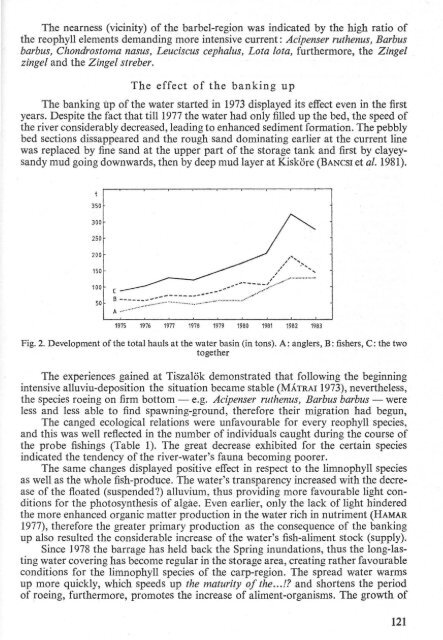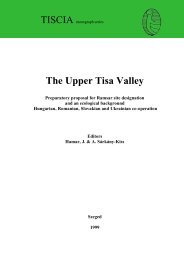full text - biokemia.bio.u-szeged.hu
full text - biokemia.bio.u-szeged.hu
full text - biokemia.bio.u-szeged.hu
You also want an ePaper? Increase the reach of your titles
YUMPU automatically turns print PDFs into web optimized ePapers that Google loves.
The nearness (vicinity) of the barbel-region was indicated by the high ratio of<br />
the reophyll elements demanding more intensive current: Acipenser ruthenus, Barbus<br />
barbus, Chondrostoma nasus, Leuciscus cephalus, Lota Iota, furthermore, the Zingel<br />
zingel and the Zingel streber.<br />
The effect of the banking up<br />
The banking up of the water started in 1973 displayed its effect even in the first<br />
years. Despite the fact that till1977 the water had only filled up the bed, the speed of<br />
the river considerably decreased, leading to enhanced sediment formation. The pebbly<br />
bed sections dissappeared and the rough sand dominating earlier at the current line<br />
was replaced by fine sand at the upper part of the storage tank and first by clayeysandy<br />
mud going downwards, then by deep mud layer at Kisköre (BANCSI et al. 1981).<br />
350<br />
300<br />
250<br />
20 0 /-,<br />
,,' ... .........<br />
150<br />
100<br />
50<br />
c<br />
_--<br />
B --- ____ ~ - : .~~ . ~. : .~.~.~. ~. ~ ............,""............... ...<br />
A .. "'"<br />
" ,<br />
~~---~--- ~.-:f'.,,· ..····,,·· ····....····-<br />
1975 1976 1977 1978 1979 1980 1981 1982 1983<br />
Fig. 2. Development of the total hauls at the water basin (in tons). A: anglers, B: fishers, C : the two<br />
together<br />
The experiences gained at Tiszalök demonstrated that following the beginning<br />
intensive alluviu-deposition the situation became stable (MÁTRAl 1973), nevertheless,<br />
the species roeing on firm bottom - e.g. Acipenser ruthenus, Barbus barbus - were<br />
less and less able to find spawning-ground, therefore their migration had begun,<br />
The canged ecological relations were unfavourable for every reophyll species,<br />
and this was well reflected in the number of individuals caught during the course of<br />
the probe fishings (Table 1). The great decrease exhibited for the certain species<br />
indicated the tendency ofthe river-water's fauna becoming poorer.<br />
The same changes displayed positive effect in respect to the limnophyll species<br />
as well as the whole fish-produce. The water's transparency increased with the decrease<br />
of the float ed (suspended) alluvium, t<strong>hu</strong>s providing more favourable light conditions<br />
for the photo synthesis of algáe. Even earlier, only the lack of light hindered<br />
the more enhanced organic matter production in the water rich in nutriment (HAMAR<br />
1977), therefore the greater primary production as the consequence of the banking<br />
up also resulted the considerable increase of the water's fish-aliment stock (supply).<br />
Since 1978 the barrage has held back the Spring inundations, t<strong>hu</strong>s the long-lasting<br />
water covering has become regular in the storage area, creat ing rather favourable<br />
conditions for the limnophyll species of the carp-region. The sp read water warms<br />
up more quickly, which speeds up the maturity of the ... ! and shortens the period<br />
of roeing, furthermore, promote s the increase of aliment-organisms. The growth of<br />
121










